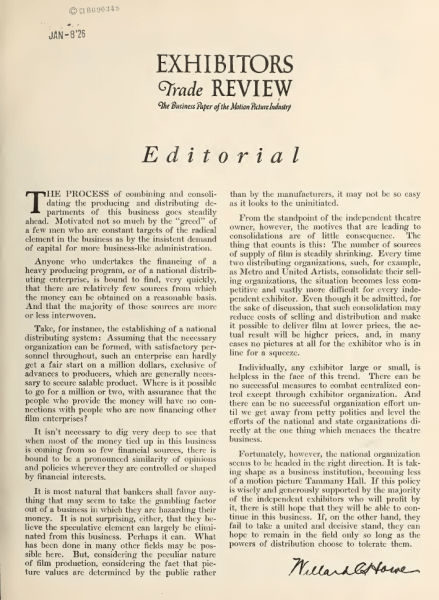| Artifact Type | Sources, Trade Journals |
| Publication | Exhibitors Trade Review |
| Volume | 19 |
| Number | 1 |
| Page Number | 13 |
| Place | New York, NY |
| Publication Date | November 21, 1925 |
| Transcript | Show/Hide |
|
Headline: “Editorial” THE PROCESS of combining and consolidating the producing and distributing departments of this business goes steadily ahead. Motivated not so much by the “greed” of a few men who are constant targets of the radical element in the business as by the insistent demand of capital for more business-like administration. Anyone who undertakes the financing of a heavy producing program, or of a national distributing enterprise, is bound to find, very quickly, that there are relatively few sources from which the money can be obtained on a reasonable basis. And that the majority of those sources are more or less interwoven. Take, for instance, the establishing of a national distributing system: Assuming that the necessary organization can be formed, with satisfactory personnel throughout, such an enterprise can hardly get a fair start on a million dollars, exclusive of advances to producers, which are generally necessary to secure salable product. Where is it possible to go for a million or two, with assurance that the people who provide the money will have no connections with people who are now financing other film enterprises? It isn’t necessaiy to dig very deep to see that when most of the money tied up in this business is coming from so few financial sources, there is bound to be a pronounced similarity of opinions and policies wherever they are controlled or shaped by financial interests. It is most natural that bankers shall favor anything that may seem to take the gambling factor out of a business in which they are hazarding their money. It is not surprising, either, that they believe the speculative element can largely be eliminated from this business. Perhaps it can. What has been done in many other fields may be possible here. But, considering the peculiar nature of film production, considering the fact that picture values are determined by the public rather than by the manufacturers, it may not be so easy as it looks to the uninitiated. From the standpoint of the independent theatre owner, however, the motives that are leading to consolidations are of little consequence. The thing that counts is this: The number of sources of supply of film is steadily shrinking. Every time two distributing organizations, such, for example, as Metro and United Artists, consolidate their selling organizations, the situation becomes less competitive and vastly more difficult for every independent exhibitor. Even though it be admitted, for the sake of discussion, that such consolidation may reduce costs of selling and distribution and make it possible to deliver film at lower prices, the actual result will be higher prices, and, in many cases no pictures at all for the exhibitor who is in line for a squeeze. Individually, any exhibitor large or small, is helpless in the face of this trend. There can be no successful measures to combat centralized control except through exhibitor organization. And there can be no successful organization effort until we get away from petty politics and level the efforts of the national and state organizations directly at the one thing which menaces the theatre business. Fortunately, however, the national organization seems to be headed in the right direction. It is taking shape as a business institution, becoming less of a motion picture Tammany Hall. If this policy is wisely and generously supported by the majority of the independent exhibitors who will profit by it, there is still hope that they will be able to continue in this business. If, on the other hand, they fail to take a united and decisive stand, they can hope to remain in the field only so long as the powers of distribution choose to tolerate them. — Willard C. Howe |
|
| Archive | The Internet Archive |
| Read In Context | https://archive.org/stream/exhibitorstrade00new#page/n17/mode/2up |
| Citation | “Editorial,” Exhibitors Trade Review, November 21, 1925. |
| Tags | 1920s1925November 1927 |
